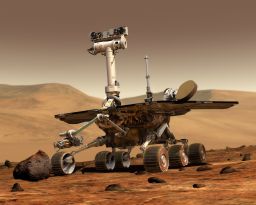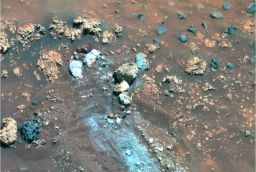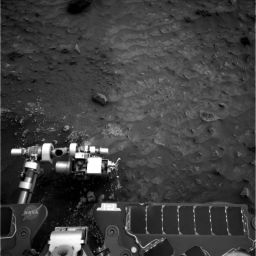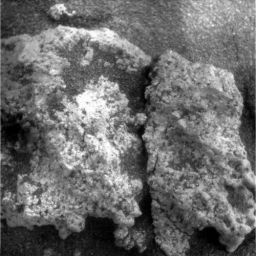A.J.S. Rayl • Aug 31, 2007
Mars Exploration Rovers Update: Spirit and Opportunity Shake Some Dust, Assess Storm Damage, and Return to Exploring
With dust from the summer's storms floating down on and all around them, the Mars Exploration Rovers returned to their exploration agendas this month, picking up right where they left off in July when winds kicked the soils up into the southern hemisphere and forced them to hunker down and conserve power.
As August set in, the storms that had been impacting the rovers appeared to be dying out. Spirit looked to be in the clear, if only metaphorically, although it was still touch-and-go for Opportunity. It had been hit hardest by the menacing, planet-circling dust storms. The darkened skies blocked direct sunlight and caused the energy -- which the solar-powered rovers glean from available sunlight -- to drop dramatically, especially on Opportunity at Meridiani Planum, which is closer to where the storms broke out.
After setting a new mission record for low energy last month with 128 watt-hours -- compared with levels above 700 watt hours in the sols before the storms hit in late June -- Opportunity was commanded to go into a very low power routine. Essentially it slept, occasionally checked the tau or opacity level of the atmosphere, and communicated only twice a week. The plan worked.
"These 'pesky' rovers survived the storms and low energy conditions and they're on the move again," confirmed geologist Ray Arvidson, deputy principal investigator for rover science in an interview yesterday. "The energy is going back up and the instruments seem to be working."
"They have both come out of the dust storms fine," elaborated Jake Matijevic, chief of the MER engineering team at JPL. "They are both back to normal operations -- that is, they are able to support daily communications with Earth and also conduct science each day."
With the storms receding, the dust is falling. That's the way it goes on Mars. So the rovers are now experiencing a steady "rain" of dust that is expected to continue for months. Although the raining dust now becomes the new "health" concern, it isn't about to stop these two intrepid robot field geologists.
"Spirit is heading up onto Home Plate and we're in the last planning stages before we expect to get confirmation for Opportunity to drive into Victoria Crater," summed up Arvidson, who took the MER science reins for Squyres for much of the month. [Squyres was leading a team to test out past and present life-seeking instruments for future Mars rovers on NASA's Arctic Mars Analog Svalbard Expedition and facing "some very challenging conditions," as he put it. "In 10 years of doing rover field tests, it turned out to be the first time I've had a command approval meeting interrupted by a polar bear," he elaborated. The humans stood down, the bear was diverted from the test rovers, and Squyres returned to his Cornell University MER base in one piece earlier this week.]
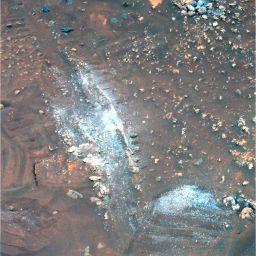 Innocent Bystander
Innocent BystanderSpriti completed its work this month on Innocent Bystander. The rover took this false color Pancam image of the silica-rich materials near the target when it accidentally crunched it up in June 2007.Credit: NASA /JPL-Caltech / Cornell
In the Columbia Hills of Gusev Crater, Spirit spent most of August at Innocent Bystander, located in the Silica Valley just east of Home Plate, Arvidson reported. When it wasn't collecting or sending home data on the storm, the rover worked on completing the in-depth study on the high silica rock it accidentally rolled over and crunched up in June.
By simply surviving the storms, Spirit managed to log another milestone for the mission. Last Friday, August 24, 2007 -- Sol 1294 at Gusev Crater -- it surpassed the Viking 2 Lander's record as the second-longest-lasting spacecraft on the surface of Mars. [Viking 1 is still number one, with six years, three months and 11 days of active service from the Martian surface. Spirit, of course, does lay claim to being the longest-lived rover on Mars.]
This week Spirit completed a post-storm checkout and today begins a series of drives that will take it on its much-anticipated, long-awaited journey up onto Home Plate, Arvidson informed.
On the other side of the planet, Opportunity was nearly inactive for the first part of August, Arvidson said. "Some days, Opportunity didn't even have enough power to use the camera to make a dust opacity measurement," recalled Diana Blaney, the MER deputy project manager at JPL, during an interview Wednesday, August 29.
Still, the rover and Mars conspired or the MER mission's "lucky star" shined again or whatever it is that gives these rovers their edge appeared and Opportunity pulled through. By last week, it had built up enough energy to take its first drive, a healthy jaunt of about 44 meters (144 feet). Another drive that followed a couple of sols later put it at the rim of Victoria Crater at Duck Bay, where it's now parked.
As Opportunity "roves" up to take its place in the top three longest-lived spacecraft on Mars's surface, it is going through the final phases of its post-storm checkout. This Labor Day weekend, the plan calls for it to take some new reconnaissance images in preparation for driving into Victoria Crater.
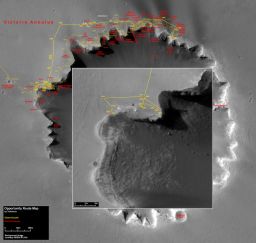 Opportunity route map to Sol 1278
Opportunity route map to Sol 1278After weeks of hunkering down and waiting out the dust storms, Opportunity finally took a drive on Sol 1271 (August 21, 2007), its first since mid-July. By Sol 1278 (August 29, 2007), the rover was poised at the rim of Victoria crater at Duck Bay.Credit: NASA / JPL / U. Arizona / Eduardo Tesheiner
"Opportunity is poised, literally with front wheels practically hanging over the edge of Victoria Crater, so we are right there at Duck Bay and very close to being ready to go in," said Squyres on his return from the Arctic. "We have a few tests we want to tick off before we go into the crater. But we're there."
During the last several weeks, the MER engineers have been "selectively" going through the rovers, "exercising certain functions with the payload, as well as the vehicle, to simply certify that there has been no change in the vehicle's performance -- and really that's been the outcome," said Matijevic. "No change in performance."
Given the gloomy outlook just one month ago, it's another comeback story for the MER books. Once again, Spirit and Opportunity have demonstrated the right robot stuff, pushed the mission into new territory, and set the rover standard even higher.
For some of the MER team, the storms were an unexpected reality check. The storms could have gotten so much worse and actually taken one -- or both -- of the golf-cart sized robot geologists out. The possibility of sudden death was not something many on the team had been contemplating much prior to this outbreak. "After the first six months, we got kind of used to the idea that these things maybe would just go on forever and when we thought about the end I think most of us have come to expect that we'd lose a wheel, then maybe an instrument would fail, and that the rovers would [suffer] a general attrition," said Blaney. "The engineers know how to work around all kinds of things, but the dust storm was out of our control. Basically, it was a matter of waiting for Mars and when the one dust storm blew in and sat right over Opportunity in July, I realized again the first time in a long, long time that how mortal these rovers are," she added. "They pulled through again this month and we've basically started back doing science and moving forward this week. But that was kind of a wake-up call for a lot of us."
Fortunately, the dust storms began to die out. The clearing on Mars began toward the end of the first week of August when weather reports from the Mars Color Imager (MARCI) camera team from the Mars Reconnaissance Orbiter (MRO) mission indicated the storms could be in the early stages of decay. Very slight clearings of the skies over Gusev and Meridiani improved the energy situation for both Spirit and Opportunity, allowing controllers to slowly their science work.
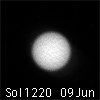 Spirit's Sun View
Spirit's Sun ViewSeveral times a sol, the rovers take images of the Sun (using a very dark solar filter) to determine the opacity of the atmosphere -- a property that is referred to as "tau". The Planetary Society's Emily Lakdawalla calibrated images that Spirit took of the Sun from Sol 1220 (June 9, 2007) through Sol 1297 (August 27, 2007) to show how dim it appeared through the dust storm. Wherever an "X" appears, the skies were so dark the rover could not muster enough power to get an image. Credit: NASA / JPL / Cornell / E. Lakdawalla
Both Spirit and Opportunity still have a ways to go before they'll see clear skies. The dust remains thick and deep in the Martian atmosphere and will remain suspended in the atmosphere for some time team members expect. By the end of August, the latest data showed that the tau at Gusev Crater was 2.5, which meant that 90% of the direct sunlight was still blocked, so Spirit is still only getting something like 10% of the available sunlight and its solar array dust factor had further deteriorated to .59 (with 1.0 being perfectly clean arrays). The rover was sporting around 310 watt-hours of power.
At Meridiani, the tau had dropped to 3.2, "roughly" translating to about 7 to 8% of light transmittal, although its dust factor -- courtesy recent dust-cleaning gusts -- was up to .85, boosting its energy up to around 350 watt-hours, according to Matijevic. "Typically, we see a tau of 1 at this time of year, the summer season, meaning we're essentially getting 35% of light transmitted. That's the norm. From 35%, we are now down to what we're getting now."
As the dust rains down, it is accumulating on all surfaces, including the rovers' solar panels and instruments. Since the solar panels generate electricity from the sunlight they take in and the dust is coating the arrays, less sunlight is getting in. Even though more sunlight is getting through the atmosphere, the rovers' ability to produce energy from that sunlight is offset or blocked by the dust that's coating their solar panels.
"The amount of dust in the atmosphere and the amount of dust in the atmosphere falling on the instruments has led us to initiate dust monitoring and dust mitigation campaigns on both rovers," Arvidson said. "For the past two weeks, the key set of activities has focused on these campaigns on both Spirit and Opportunity and we're folding those into the daily activities."
There's so much dust about Spirit and Opportunity that Arvidson suspects that during the peak of the dust storms local wind gusts stirred up sand and dust that also wound up on the twin robots. The team is in the process of assessing and recalibrating how it actually takes the raw data and converts it to physical units.
"We want to make sure that if there is dust on some of the windows and lenses that we characterize the pattern as a function of time, because that impacts how we process the data," he explained. "It also impacts the numerical value we get for optical depth since the way we get that number is by taking an image of the Sun with the Pancam." It could be, he added, that if there is dust on the windows they're seeing dust on the windows and in the atmosphere, then they may be overestimating the optical depth. "Until we get the new calibration measurements done, we won't know."
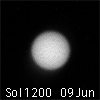 Opportunity's Sun View
Opportunity's Sun ViewAs above, The Planetary Society's Emily Lakdawalla calibrated images that Opportunity took of the Sun from Sol 1200 (June 9, 2007) through Sol 1276 (August 26, 2007) to show how dim it appeared through the dust storm. The effort was recongized this week in a press release from Cornell, where the mission's lead rover scientists Steve Squyres and Pancam lead Jim Bell are based. Credit: NASA / JPL / Cornell / E. Lakdawalla
One thing they do know is that the dust will continue to fall for weeks, even months to come. "The skies may not be clearing nearly as quickly as we would like, but they are clearing at exactly the speed we expected," Squyres said. "You can't argue with Stokes law -- [which] decribes how rapidly particles settle in a fluid. The dust just can't settle any faster. Even if you turn off all the winds, it takes weeks for dust this fine to settle out."
As part of the dust monitoring and mitigation campaigns, the MER team is continuing to look for any "injuries" that the individual electronic or scientific instruments may have sustained during the storms. Team members have obvious concerns about dust having blown into and onto some of the devices.
Clumps of dust appear to have penetrated the optics of the microscopic imager (MI) on Spirit. Although engineers have already had it conduct some maneuvers to knock some of it out, the process continues. Other instruments, particularly on Opportunity, are being checked carefully. "We have been concerned that the alpha particle X-ray spectrometer (APXS) on either rover may have had some dust accumulate on the detectors inside or on the foil that covers the radioactive source, so we've been making a set of measurements to determine if dust has settled on the detectors or the sources," Arvidson said. "Spirit is clear. We're in the process of understanding Opportunity."
Remarkably -- although the MERs were not designed to withstand one Martian dust storm, much less a series of them -- both Spirit and Opportunity appear to have come through the storms relatively unscathed. "It is remarkable," said Matijevic. "It's sort of less remarkable after we're coming out of the circumstance than it was during that entire month [July] when we were having to deal with low energy situations and debating the dire consequences that might happen if the energy dropped even more."
The deluge of dust now dropping on the rovers will continue to be of concern, not necessarily for the immediate future, but for the coming winter, especially for Spirit. Because of its location, this rover must spend the season on a 10-degree slope in order to get enough Sun power to survive. "Our experience [informs us] that we'll see a constant deposition of dust all the way to the winter season -- and if there's no change in that [if Spirit doesn't get its arrays cleaned], then we could have rather harsh conditions during the winter again," Matijevic said.
For now, however, there's no reason to expect the worst. "With Opportunity, there have been dust-cleaning events -- it's somewhat dynamic atmospheric time of year and it may not be unreasonable to expect that kind of behavior to continue, even recur at the Spirit site," Matijevic rationalized. "It's hard to claim that there's anything that necessarily bodes dire consequences for the vehicles from this point on."
Opportunity's dust-cleaning gust of last week was followed by a few more, although Spirit has not been so lucky. "You can see that there has been some movement of dust in and around Spirit's area and we're thinking that may have been part of the environment in which we've seen some surfaces of the instrument deployment device (IDD) cleaned, but that's all," said Matijevic. "We've not seen the same kind of array cleaning on Spirit as we have seen on Opportunity. We're a little disappointed in that. But at the same time, these are really two different places."
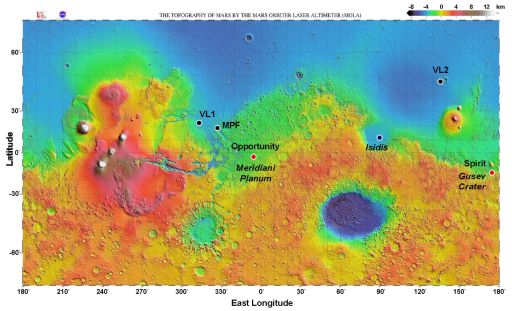 Mars landing sites
Mars landing sitesThis image, taken by the Mars Orbiter Laser Altimeter (MOLA) onboard the late Mars Global Surveyor shows the locations of NASA's landers and rovers on Mars. VL1 is Viking Lander 1, a stationary robot from 1976. MPF is Mars Pathfinder, a 1997 lander that featured a small rover named Sojourner. Opportunity/Meridiani Planum is the second of the Mars Exploration Rovers (MERs) that landed in 2004. Isidis was the projected landing site for the European Space Agency's Beagle 2 stationary lander that was lost on arrival at Mars in 2003. VL2 is Viking Lander 2 that landed in 1976. Spirit/Gusev Crater is where the first MER landed in 2004.Credit: NASA / JPL-Caltech / GSFC
Another month turns into another successful chapter for the MERs. "Every day is still a surprise," Arvidson said, as many team members have often said. "We're now passed 1300 sols on Spirit. I initially was prepared for 90. I've given up on when the end of the mission is going to be. Actually I expected Spirit -- and Opportunity -- would make it through these dust storms, but we all knew it would be a long haul with some uncertainty."
While summer is coming to an end in the northern hemisphere on Earth, it lingers on in the southern hemisphere on Mars where the rovers are and, as it does, so too does the dust storm season. For now, the latest weather reports from MARCI continue to show no new storm activity visible within a few thousand kilometers of either Mars rover site and the skies are expected to continue to gradually brighten above both Gusev Crater and Meridiani Planum. For now, the mood is optimistic. "The conditions keep getting better and we have seen a gradual improvement in the tau and the power and both rovers are on the move again," noted Squyres. "And," said Arvidson with a smile, "I expect in a couple of weeks Opportunity will be inside Victoria Crater."
Spirit From Gusev Crater
Spirit spent most of the month of August just east of the raised volcanic formation known as Home Plate, at the high silica rock target Innocent Bystander. It hunkered down there in mid-July when the storms began to darken the skies over Gusev Crater.
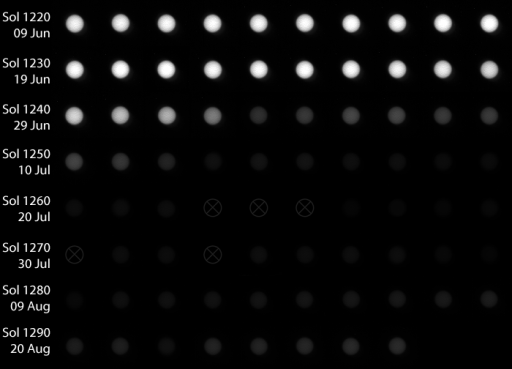 Spirit's dimming Sun
Spirit's dimming SunSeveral times a sol, the Mars Exploration Rovers take images of the Sun (using a very dark solar filter) to determine the opacity of the atmosphere -- a property that is referred to as "tau." Here are the images that The Planetary Society's Emily Lakdawalla calibrated of Spirit's dimming view of the Sun, from the rover's Sol 1220 (June 9, 2007) through Sol 1297 (August 27, 2007) compiled together in one image. "Emily's Sun mosaics are the highlight of the month for me, not only because they're cool but because they show the Sun returning -- slowly, but surely," said Pancam lead Jim Bell of Cornell, which issued a press release heralding the mosaics earlier this week. Wherever a circle with an "X" appears, the skies were so dark that Spirit could not muster enough power to perform its usual tau measurements.Credit: NASA / JPL / Cornell / E. Lakdawalla
During the first week of the month, Spirit kept up with -- and increased -- its daily atmospheric measurements, surveying the ground and sky at different elevations using the miniature thermal emission spectrometer (Mini-TES), making multiple measurements of atmospheric dust opacity or tau at different times of day with the navigation camera and the panoramic camera (Pancam), adding wide-range Pancam images to the mix, as well as surveying the sky and Sun with the Pancam and monitoring dust accumulation on itself.
The rover followed commands to use its power conservatively, but since its energy levels were high going into the storms, it still had enough reserve to conduct a good amount of science on the rock target it accidentally crunched up in June.
Another experiment that began in the first days of August involved taking images of nearby sand ripples and the El Dorado dune field with the front and rear hazard cameras, the navigation camera and the Pancam to monitor how the terrain changed and moved with the winds.
Spirit also spent a lot of time -- around 150 hours -- looking for the iron content in Innocent Bystander with the Mössbauer spectrometer. "Since Innocent Bystander didn't have much iron in it, the original Mössbauer readings we got didn't really tell us much, so we used the opportunity that we didn't have enough power to drive to do long integrations with that instrument," explained Blaney.
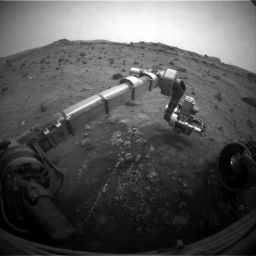 Spirit gets back to work
Spirit gets back to workSpirit moved its instrument deployment device (IDD) or robotic arm for the first time in 20 days on Sol 1277 (Aug.6, 2007). Teams operating the rovers kept their activity levels very low through July and early August, because dust storms obscured much of the sunshine on which the rovers rely for their solar arrays to generate electricity. However, when the sky cleared enough above Spirit by Sol 1276, the team decided it could carry on with its science work and position the microscopic imager on Innocent Bystander and two soil targets nearby. The rover took this image with the left hazard-identification camera during Sol 1277 to document that the arm had repositioned the microscopic imager.
Credit: NASA /JPL-Caltech / Cornell
Throughout the first week of August, Spirit's energy continued to hold steady, just under 300 watt-hours, but its schedule has been cut way back because of what was going on with Opportunity at Meridiani. Over the first weekend of the month, Sols 1275-1276 (August 4-5, 2007), the tau hovered around 3.8 at Gusev, but since the rover's solar power level registered at 295 watt-hours and its batteries were nearly fully charged. The apparent relative stability of the atmosphere and the slowly increasing energy motivated the rover planners (RPs) to return to somewhat normal planning procedures, allowing Spirit to take on more science activities. The rover immediately placed the Mössbauer spectrometer on Innocent Bystander on Sol 1275 (August 4, 2007) for a long integration, and continued the long examination of it on Sols 1278 and 1281 (August 7 and August 10, 2007).
On Sol 1276 (August 5, 2007) Spirit began acquiring images of ripples for the dust movement study with the front and rear hazard avoidance cameras. It also began taking wide-range, Pancam images for measuring atmospheric dust and also took a 360-degree panorama of its surroundings and searched for clouds with the navigation camera.
After completing its now-requisite atmospheric observations on Sol 1277 (August 6, 2007), Spirit moved its IDD or robotic arm for the first time in nearly three weeks. It positioned the MI to take a series of photographs of Innocent Bystander and two specific soil targets around it, dubbed Stealing Second and Stealing Third.
As the second week of the month got underway, the tau seemed to be stabilizing at around 3.8 and Spirit's power was still consistently around 296 watt-hours and the rover returned to regular communications sessions, taking its direct-from-Earth uplinks over its high-gain antenna in the morning and sending relays to Earth at UHF frequencies via the Odyssey orbiter in late afternoon local Mars time. It also continued its daily dust monitoring, the Mössbauer study of Innocent Bystander, image study of the ever-moving sand ripples around it, and even snapped some movie frame images in search of dust devils with the navigation camera.
 Dust in the wind and on the lens
Dust in the wind and on the lensSpirit used its microscopic imager (MI) to take a picture of the instrument through the dust cover on Sol 1279 (Aug. 9, 2007). The MI appeared to take in some dust from the series of recent storms and the team has beenworking to get it out since then. Credit: NASA / JPL - Caltech
On Sol 1279 (August 8, 2007), the MER team realized that the MI appeared to have some dust particles on its optics, so it used the instrument to snap an image of itself, looking through the dust cover, then used the Pancam and navigation cameras to take pictures of it from the outside. Since the MI had not been used since Sol 1257, it is unclear if the contamination occurred prior to the images taken on Sol 1277 when the team first saw it or if it occurred at the start of the Sol 1277 images when the protective dust cover was opened.
In the sols that followed, Spirit measured atmospheric properties using the APXS as part of an ongoing experiment to determine the amount and role of argon in the Martian atmosphere, continued its Mössbauer study of Innocent Bystander, and the sand ripple image experiment, conducted more searches for clouds with the navigation camera.
The RPs put Spirit through some IDD exercises on Sol 1282 (August 11, 2007), commanding it to first extend it for Pancam images, then retract it for hazard avoidance camera images, then finally extend it again to put the rock abrasion tool (RAT) in a ready position.
Even though the Martian sky above Gusev Crater continued to clear, solar power levels on Spirit remained fairly constant, because the settling dust was blanketing its solar panels. By Sol 1286 (August 16, 2007), the tau decreased to 3.3. But Spirit's solar array dust factor deteriorated to 0.689 as the dust rained out of the skies, offsetting some of the improvement in tau and keeping the rover's energy levels right around 300 watt-hours. [A dust factor of 1.0 corresponds to a perfectly clean solar array. Prior to the storms, each rover was boasting more than twice that amount of energy.]
On Sols 1286-1287 (August 16-17, 2007), Spirit took more diagnostic images at different times of day looking skyward through the dust cover with the MI, trying to help engineers figure out how to shake loose the dust that had come to contaminate the optics. Meanwhile, on Earth, engineers were conducting tests with an MI on a surrogate rover in the indoor Mars Yard at JPL, eager to initiate what they took to calling a "blobs away" campaign.
Around this time, Spirit completed its Mössbauer analysis of Innocent Bystander after some 150 hours, making this high silica rock the longest Mössbauered target on the mission. "We've learned it is a high silica rock with not much iron at all," chuckled Arvidson. "Without much iron you need a long, long integration to get a good signal-to-noise ratio and to figure out the mineralogy of the iron-bearing minerals. Remember, we're relying on gamma rays given out by the iron and if there isn't much iron you have to sit for a good long time. Plus the cobalt-57 [power source] has a lifetime of 200 days, so what took four hours with the Mössbauer spectrometer at the beginning of the mission now takes 4 or 5 days."
"We have been able to show that what little iron bearing minerals are in these high silica rocks are very similar to the rest of the iron-bearing materials in the vicinity," added Blaney. "We're still trying to put that in context of what it means in the big picture but we think it's an important piece of the data to figure out how these silica deposits got formed."
The beginning of the third week of August on Mars brought more good weather news. The reports provided by Malin Space Science Systems, the builder of the Mars Color Imager (MARCI) onboard MRO, forecast no new dust storm activity for the coming week. The gloominess caused by suspended dust in the atmosphere remained high, but the trend showed a continued brightening of the skies over both Meridiani Planum and Gusev Crater.
Spirit remained healthy even as the amount of dust hoisted into the atmosphere by recent windstorms settled on its arrays, with energy levels continuing to hold steady at about 280 to 300 watt-hours. Its work on Innocent Bystander officially complete, the rover turned its scientific mind to Norma Luker, another white chunky piece of rock near the crushed rock on which it had spent so much time this summer. The rover checked out the new target's composition with the APXS, then conducted some more post-storm checkouts of its IDD for the engineers.
On Sol 1290 (August 20, 2007), the rover finally initiated the "blobs away" campaign. Designed to dump dust from the surface of the MI lens, the campaign, involved repeatedly taking images, opening and closing the dust cover, pointing the instrument slightly upward at an angle of 20 degrees (with the hinge down to avoid dumping caked dust on the lens), and taking more images and opening and closing the dust cover. "It seemed to have moved a little bit of the material out of the unit," explained Matijevic. "Some of the contamination may have been dust deposited on the lens and some may have been on the cover itself, but the combination was that there was some improvement in the images from the MI as a consequence." The dust decontamination efforts were slated to continue.
The next sol, Spirit focused the MI pictures on Norma Luker, then moved the instrument to take some close-up, stereo views of surface ripples. It then stowed the IDD and took a picture of the action with the hazard avoidance camera to document the stowing of the arm in what was another post-storm checkout.
At the same time back on Earth, MER team members studied the images of the ripples. "This is the first opportunity to look at a dust storm from the surface and its impact and we're pretty intrigued with the images we're getting," Blaney noted. "I think everyone was surprised at how much material seemed to get moved around on the ground during these storms. We've been roving around and spent the winter at Low Ridge for many, many months and nothing changed. Here, in these images, we can see changes from one day to the next. These winds really mobilized a large amount of material," she said. "For me, it puts a new perspective on the idea that things may not get mobilized on Mars except in these larger events, that there may be a real threshold. In terms of Aeolian processes on Mars, these large storms may be very important for a lot of reasons in terms of mobilizing sand dunes and things like that," she suggested. "Hopefully from that we'll be able to put some information together about dune migration on Mars."
Dust falling out of the atmosphere continued, not surprisingly, to limit power gains from the decreasing tau. Between Spirit's 1288th and 1291st sols (August 18-21, 2007), tau values dropped from 3.2 to 3.0. During the same time, the accumulation of dust on the solar arrays deteriorated a bit more, from 0.664 to 0.640. [A dust factor of 1.0 corresponds to a perfectly clean array.] Still, solar energy was creeping up and on Sol 1291 (August 21, 2007) was 313 watt-hours.
As the final week of August got underway, the plans sent up on Sol 1292 (August 22, 2007) commanding the rover to spend the next sol conducting remote sensing and taking full-color images of Eileen Dean failed to get onboard Spirit. The JPL engineers immediately began investigating the possible cause for the failed communiqué. The initial notion was there might have been an uplink glitch or interference from a simultaneous uplink to MRO.
Undaunted, Spirit carried on up on Mars, checking out the Mini-TES, acquiring movie frames in search of dust devils with the navigation camera, and snapping some full-color Pancam images of Gertrude Weise, the 90% pure silica soil target the rover had examined this spring. After collecting some Mini-TES data from the target, the rover scooted backward 42 centimeters (16.5 inches) to get in position for taking some final images of Innocent Bystander on Sol 1293 (August 23, 2007).
"We had been parked at Innocent Bystander in a position to do some of the detailed in situ work with the instruments on the IDD when the dust storms hit," recalled Matijevic. "So we finished up that work and in backing up provided a visual field of view for the cameras and the Mini-TES to actually take measurements after this in situ work had been completed. We realized there had been some small changes in the local surroundings of this site – before and after the main aspects of the dust storm."
After finishing its imaging work of Innocent Bystander and other targets there in the Silica Valley, Spirit took "a little dogleg" jaunt, returning to Gertrude Weise to crunch it up and look deeper inside, beneath the surface. "We want to get more of the white or light-toned material -- the high silica material -- exposed," Arvidson explained. "Then we'll look at it in detail with Mini-TES, because Mini-TES may have gotten more dust on its mirror. We need to calibrate Mini-TES' ability to see the high silica signature and we can't use Gertrude Weise the way it is, because it has dust on it. So we're tearing that material up with the wheels." Today, the plans called for the rover to back away from Gertrude Weise and target it with Mini-TES.
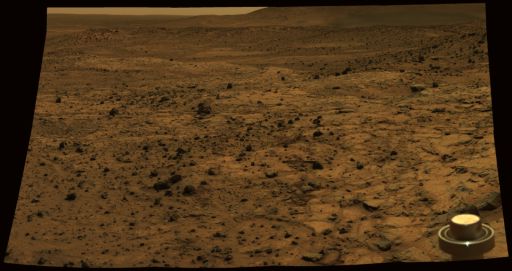 The view from Home Plate
The view from Home PlateSpirit took this mosaic from the top of Home Plate on Sol 773 (March 6, 2006). The view spans about 70°. The dusty conditions on Mars over the last six week or so have given the Pancam team time to better process the image, said Pancam lead Jim Bell. The rover is scheduled to drive back onto Home Plate this weekend (September 1-2, 2007).Credit: NASA / JPL-Caltech / Cornell
Through the storm and the post-storm checkouts, Spirit has performed "just fine," Matijevic said. "Nothing's changed with right front drive actuators, but the techniques we developed for driving a five-wheeled rover and have used in the past applied just fine again," he noted. "Through a combination of slip measurements and checking of the yaw introduced as a consequence of the wheel dragging, the onboard sequences are able to command the vehicle in such a fashion that the vehicle pretty much ends up where we have predicted."
This weekend, Spirit is scheduled to make the first of multiple drives up onto Home Plate. "It should be up on it by the end of next week," Arvidson said.
Opportunity from Meridiani Planum
As July gave way to August, the tau or atmospheric opacity continued to increase at Meridiani Planum, but Opportunity followed the new lower-power plan sent up and managed to tough it out, though with very low power. The 128 watt-hour level it fell to at the beginning of July remained the low point, and during the month of August, the rover slowly increased its power.
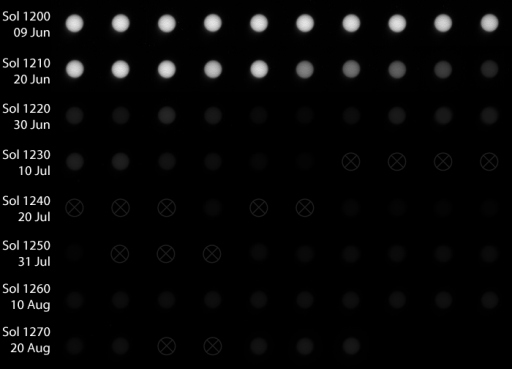 Opportunity's dimming Sun
Opportunity's dimming SunSeveral times a sol, the Mars Exploration Rovers take images of the Sun (using a very dark solar filter) to determine the opacity of the atmosphere -- a property that is referred to as "tau." Here are the images that The Planetary Society's Emily Lakdawalla calibrated of Opportunityt's dimming view of the Sun, from the rover's Sol 1200 (June 9, 2007) through Sol 1276 (August 26, 2007) compiled together in one image. "Emily's Sun mosaics are the highlight of the month for me, not only because they're cool but because they show the Sun returning -- slowly, but surely," said Pancam lead Jim Bell of Cornell, which issued a press release heralding the mosaics earlier this week. Wherever a circle with an "X" appears, the skies were so dark that Spirit could not muster enough power to perform its usual tau measurements.Credit: NASA / JPL / Cornell / E. Lakdawalla
While the MER team's lower-power plan worked, keeping Opportunity's activities and communications to a minimum also reduced the amount of energy going into the rover's electronics module (REM) -- the centerpiece of the vehicle that houses the sensitive electronics and scientific instruments. That meant the electronic components themselves in the core were not being kept as warm as they had been. Moreover, as explained the last MER Update, the temperature inside the REM dropped even lower than the outside temperature, putting the rover in a tenuous position and threatening some of those electronics. Welcome to Mars.
The implementation of the lower-power schedule resulted in the overnight low temperature of Opportunity's electronics module dropping about 1 degree Celsius (C) every night. "We were just not awake long enough," said Matijevic. "Simply operating the computer and supporting electronics for a certain time each day allows the REM to, in effect, build up a heat mass that allows the instruments and electronics to ride out the nighttime drop in temperatures," explained Matijevic.
The potential problem was that Opportunity was programmed to turn the survival heaters on in the REM if the temperatures ever dropped below -39 degrees C (-38.2 F). The heaters would consume 60 watt-hours of energy, half or more of the rover's paltry supply. It was energy the rover didn’t have. If the heaters consumed the solar power and then began drawing the battery power down, Opportunity would trip a low-power fault, go into survival mode.
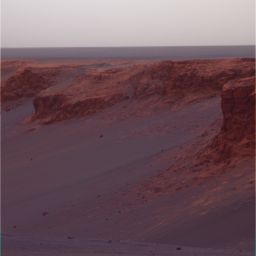 Before the storm
Before the stormOpportunity took this Pancam image from its current position off the rim at Duck Bay, Victoria Crater in the early days of July just before the team commanded her to suspend science operations. In the hours following, the skies darkened with dust and the rover hunkered down to wait out the storm.
Credit: NASA /JPL-Caltech / Cornell
Basically, tripping the fault would mean Opportunity would take its batteries off-line and put itself to sleep, much like C3PO went offline for some rest in the original Star Wars. It would then check each sol to see if there is sufficient available energy to wake up and perform daily fault communications. If not, it would go back to sleep. Depending on the weather and atmospheric opacity conditions, it could hibernate for days, weeks, or even months, all the while trying to charge the batteries with whatever available sunlight there might be. Opportunity might not be "reachable" for months, if it was able to survive the shock of shutdown and restart.
"When we discovered the plans we put in to conserve energy were causing this electronic module to dip lower in temperature, we changed the plan around to have the rover do a little bit more during in the daytime and thereby build up a thermal mass in the module, and prevent those heaters from kicking on," said Matijevic. Additionally, the engineers modified the onboard parameters to disable the REM survival heaters when the rover is awake. It could have sent the rover into negative-net-energy status, but the skies began to clear and the outlook improved. As it turned out, Opportunity didn't trip the fault and never went into negative-net-energy.
Following the Sol 1254-1255 (August 4-5, 2007) weekend, the tau at Meridiani Planum decreased to about 4.0, and Opportunity was boasting solar power energy levels of 243 watt-hours. Better still, its batteries wear near a full state of charge and the daily low temperature in the REM was back up, to -33.4 degrees C (-28.1 F). The MER team continued a cautious approach, configuring Opportunity and limiting communication sessions so that it would maintain a high state of charge on the batteries, but with the slight improvements in the power situation, the it was able to add occasional atmospheric monitoring tasks to the rover's agenda.
As August drolled on at Meridiani and the second week of the month took hold, the dust continued to rain down from the skies. The tau finally dropped below 4, to 3.8, then lingered around 3.6 for several sols with solar array energy around 243 watt-hours. The minimum REM temperature stabilized at around -32.5 degrees C (-26.5).
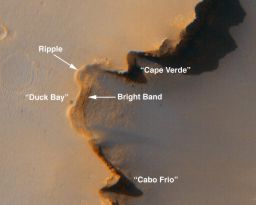 Duck Bay
Duck BayThis image shows Duck Bay, the site where Opportunity will carefully roll down into Victoria Crater. Duck Bay has gradual slopes of about 15 to 20 degrees and exposed bedrock, making it the safest place for the rover to enter the crater. Rover drivers plan to avoid a rippled portion of terrain near the rim of the crater, and to steer Opportunity down the smoothest bedrock with the gentlest slopes.This enhanced-color view was taken by the High Resolution Imaging Science Experiment (HiRISE) camera onboard the Mars Reconnaissance Orbiter (MRO) spacecraft on Oct. 3, 2006.Credit: NASA / JPL / Univ. of Ariz.
The falling dust accumulating on Opportunity's solar arrays was by mid-month offsetting the energy boost from the clearing skies, just as it was on Spirit. Still, the rover's dust factor was livable at 0.721. Dust and atmospheric opacity fluctuations came with the fallout. On Sol 1269 (August 19, 2007), Opportunity's energy dropped a bit, to 235 watt-hours, although its batteries remained almost fully charged. The REM daily low temperature remained stable. It was painfully slow progress, but for a rover that just a few weeks ago many thought would not make it out of the storms "alive," it was all good.
On Sol 1271 (August 21, 2007), Opportunity drove for the first time since Sol 1232 (July 12, 2007) when the dust storms forced it to hunker down. It took a healthy little jaunt along Duck Bay, 13.38 meters (44 feet) toward the rim of Victoria Crater, the impact hole that stretches 740 meters (2428 feet) in diameter.
Mission controllers were taking advantage of gradual clearing of dust from the sky, as well as precautions against a buildup of dust settling onto the rover. If the pace of dust accumulation on the solar panels increased, the rover team wanted to be able to get Opportunity onto the inner slope of the crater where it could position itself and tilt its solar arrays toward the Sun to maximize daily energy supplies. The drive was also designed to check performance of the rover's mobility system, said Matijevic, so it included a turn in place and a short drive backwards, some of which may have helped knock some dust off.
In any case, the very next sol -- 1272 -- Mars smiled on the golfcart-sized rover and offered up a gust of wind that removed enough dust to provide a boost of about 10 percent in energy. It made the need to hurry to a Sun-facing slope less urgent. By Sol 1273 (August 23, 2007), Opportunity's daily supply of electricity reached nearly 300 watt-hours -- more than twice as much as five weeks ago when its life was threatened, but still less than half as much as two months ago. It was enough for another drive.
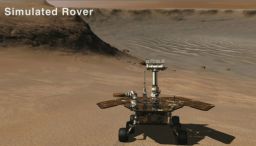 Opportunity ready to roll
Opportunity ready to rollThis image shows a simulated Opportunity ready to descend into Victoria Crater via the rock-paved slopes of an alcove dubbed Duck Bay. If all goes according to plan, the rover will take it first roll inside the crater in September. The rover will examine the deeper, older rocks that might hold clues to Mars' wet past. Duck Bay has slopes of about 15 to 20 degrees and exposed bedrock, making it the safest site for entry.
Credit: NASA / JPL / Cornell
"We had quite a bit of dust on the IDD and that seemed to pretty much have cleared up simply because of the changing environment conditions," Matijevic said. "We moved [the rover] a little and moved the IDD around a bit as we commonly do to stow and unstow as we're driving. All that was enough to make some difference in terms of dust deposited. It's not like the wind blowing dust off a car that takes off, but some dust may have come off a bit as a result of vibration introduced."
The vehicles are designed to create a smooth ride for the payload, which is primarily sitting in the REM box, Matijevic noted. "However, it may have shaken a little as a consequence of moving around and periodically we'll get some small vibrations that come from having the wheels turn or lock or something like that and that can take place. But that's about it. Maybe that contributed to this cleaning, clearing, maybe it didn't," said Matijevic.
Since then, however, Mars seems to have almost apologized to Opportunity for the storm with "a steady stream of dust-cleaning events, four so far," said Squyres. Now, again, Victoria Crater -- the once impossible target -- lies ahead and Opportunity is making final preparations for the journey in.
"We've done a little bit of checkout of the instruments post-dust storm to see how the IDD is functioning and checking out the instruments," said Blaney. But there isn't any real rush, she added. "We need to let the sky clear and the power levels to come up more before we try that."
"We're doing the dust mitigation campaign and checking out all the instruments before we get confirmation that we can enter the crater and begin the Victoria campaign," Arvidson expounded.
On Sol 1278 (August 29, 2007), Opportunity bumped into a position right near the rim. Over the Labor Day weekend, the rover is slated to take new reconnaissance pictures of the planned entry point at Duck Bay, which is about 40 meters (131 feet) away. "We're a little concerned about what the dust storms might have done to change the terrain and the entry site," said Matijevic.
Just exactly when Opportunity will enter the crater will depend on assessments of those images and other data that may reveal how dust is affecting the instruments and of how much energy will be available. But Arvidson, Matijevic, and Blaney seemed certain September will be a month to remember.
For all the MER Updates, go to: http://www.planetary.org/explore/space-topics/space-missions/mer-updates/
Support our core enterprises
Your support powers our mission to explore worlds, find life, and defend Earth. You make all the difference when you make a gift. Give today!
Donate

 Explore Worlds
Explore Worlds Find Life
Find Life Defend Earth
Defend Earth


